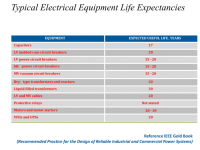- Location
- Lockport, IL
- Occupation
- Semi-Retired Electrical Engineer
Is there a "standard" that states how long electrical components should last before exceeding a reasonable life expectancy? I am talking about "major" components (e.g., switchboards, panelboards, transformers, motors, conductors and such), not the "small stuff" (e.g., switches, relays, luminaires, and such). I have generally thought 40 years was reasonable, though we have all seen things far older.
I am working on a project that will upgrade the main service and some downstream panels for three old buildings. We are saying these items have exceeded their useful lives. But the accounting folks are challenging us to produce a standard that backs up our claim that replacements are needed.
Any ideas?
I am working on a project that will upgrade the main service and some downstream panels for three old buildings. We are saying these items have exceeded their useful lives. But the accounting folks are challenging us to produce a standard that backs up our claim that replacements are needed.
Any ideas?


